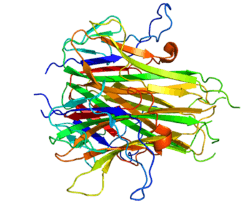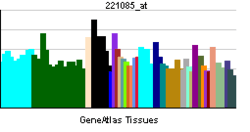Vascular endothelial growth inhibitor
| View/Edit Human | View/Edit Mouse |
Vascular endothelial growth inhibitor (VEGI), also known as TNF-like ligand 1A (TL1A) and TNF superfamily member 15 (TNFSF15), is protein that in humans is encoded by the TNFSF15 gene. VEGI is an anti-angiogenic protein.[4] It belongs to tumor necrosis factor (ligand) superfamily, where it is member 15.[5] It is the sole known ligand for death receptor 3,[6] and it can also be recognized by decoy receptor 3.
Function
The protein encoded by this gene is a cytokine that belongs to the tumor necrosis factor (TNF) ligand family. This protein is abundantly expressed in endothelial cells, but is not expressed in either B or T cells. The expression of this protein is inducible by TNF-alpha and IL-1 alpha. This cytokine is a ligand for receptor TNFRSF25 (death receptor 3) and TNFRSF6B (decoy receptor 3). It can activate both the NF-κB and MAPK signalling pathways, and acts as an autocrine factor to induce apoptosis in endothelial cells. This cytokine is also found to inhibit endothelial cell proliferation, and thus may function as an angiogenesis inhibitor. An additional isoform encoded by an alternatively spliced transcript variant has been reported but the sequence of this transcript has not been determined.[5]
Clinical relevance
Several TNFSF15 SNPs have been found to be strongly associated with inflammatory bowel disease.[7][8]
References
- ↑ "Diseases that are genetically associated with TNFSF15 view/edit references on wikidata".
- ↑ "Human PubMed Reference:".
- ↑ "Mouse PubMed Reference:".
- ↑ Hoffmann R, Valencia A (Jul 2004). "A gene network for navigating the literature". Nature Genetics. 36 (7). doi:10.1038/ng0704-664. PMID 15226743.
- 1 2 "Entrez Gene: TNFSF15 tumor necrosis factor (ligand) superfamily, member 15".
- ↑ Wang EC (Sep 2012). "On death receptor 3 and its ligands…". Immunology. 137 (1): 114–116. doi:10.1111/j.1365-2567.2012.03606.x. PMC 3449252
 . PMID 22612445.
. PMID 22612445. - ↑ Picornell Y, Mei L, Taylor K, Yang H, Targan SR, Rotter JI (Nov 2007). "TNFSF15 is an ethnic-specific IBD gene". Inflammatory Bowel Diseases. 13 (11): 1333–8. doi:10.1002/ibd.20223. PMC 2552994
 . PMID 17663424.
. PMID 17663424. - ↑ Kakuta Y, Kinouchi Y, Negoro K, Takahashi S, Shimosegawa T (Oct 2006). "Association study of TNFSF15 polymorphisms in Japanese patients with inflammatory bowel disease". Gut. 55 (10): 1527–8. doi:10.1136/gut.2006.100297. PMC 1856432
 . PMID 16966713.
. PMID 16966713.
Further reading
- Tan KB, Harrop J, Reddy M, Young P, Terrett J, Emery J, Moore G, Truneh A (Dec 1997). "Characterization of a novel TNF-like ligand and recently described TNF ligand and TNF receptor superfamily genes and their constitutive and inducible expression in hematopoietic and non-hematopoietic cells". Gene. 204 (1-2): 35–46. doi:10.1016/s0378-1119(97)00509-x. PMID 9434163.
- Zhai Y, Ni J, Jiang GW, Lu J, Xing L, Lincoln C, Carter KC, Janat F, Kozak D, Xu S, Rojas L, Aggarwal BB, Ruben S, Li LY, Gentz R, Yu GL (Jan 1999). "VEGI, a novel cytokine of the tumor necrosis factor family, is an angiogenesis inhibitor that suppresses the growth of colon carcinomas in vivo". FASEB Journal. 13 (1): 181–9. PMID 9872942.
- Yue TL, Ni J, Romanic AM, Gu JL, Keller P, Wang C, Kumar S, Yu GL, Hart TK, Wang X, Xia Z, DeWolf WE, Feuerstein GZ (Jan 1999). "TL1, a novel tumor necrosis factor-like cytokine, induces apoptosis in endothelial cells. Involvement of activation of stress protein kinases (stress-activated protein kinase and p38 mitogen-activated protein kinase) and caspase-3-like protease". The Journal of Biological Chemistry. 274 (3): 1479–86. doi:10.1074/jbc.274.3.1479. PMID 9880523.
- Haridas V, Shrivastava A, Su J, Yu GL, Ni J, Liu D, Chen SF, Ni Y, Ruben SM, Gentz R, Aggarwal BB (Nov 1999). "VEGI, a new member of the TNF family activates nuclear factor-kappa B and c-Jun N-terminal kinase and modulates cell growth". Oncogene. 18 (47): 6496–504. doi:10.1038/sj.onc.1203059. PMID 10597252.
- Yu J, Tian S, Metheny-Barlow L, Chew LJ, Hayes AJ, Pan H, Yu GL, Li LY (Dec 2001). "Modulation of endothelial cell growth arrest and apoptosis by vascular endothelial growth inhibitor". Circulation Research. 89 (12): 1161–7. doi:10.1161/hh2401.101909. PMID 11739281.
- Migone TS, Zhang J, Luo X, Zhuang L, Chen C, Hu B, Hong JS, Perry JW, Chen SF, Zhou JX, Cho YH, Ullrich S, Kanakaraj P, Carrell J, Boyd E, Olsen HS, Hu G, Pukac L, Liu D, Ni J, Kim S, Gentz R, Feng P, Moore PA, Ruben SM, Wei P (Mar 2002). "TL1A is a TNF-like ligand for DR3 and TR6/DcR3 and functions as a T cell costimulator". Immunity. 16 (3): 479–92. doi:10.1016/S1074-7613(02)00283-2. PMID 11911831.
- Chew LJ, Pan H, Yu J, Tian S, Huang WQ, Zhang JY, Pang S, Li LY (May 2002). "A novel secreted splice variant of vascular endothelial cell growth inhibitor". FASEB Journal. 16 (7): 742–4. doi:10.1096/fj.01-0757fje. PMID 11923219.
- Wen L, Zhuang L, Luo X, Wei P (Oct 2003). "TL1A-induced NF-kappaB activation and c-IAP2 production prevent DR3-mediated apoptosis in TF-1 cells". The Journal of Biological Chemistry. 278 (40): 39251–8. doi:10.1074/jbc.M305833200. PMID 12882979.
- Bamias G, Martin C, Marini M, Hoang S, Mishina M, Ross WG, Sachedina MA, Friel CM, Mize J, Bickston SJ, Pizarro TT, Wei P, Cominelli F (Nov 2003). "Expression, localization, and functional activity of TL1A, a novel Th1-polarizing cytokine in inflammatory bowel disease". Journal of Immunology. 171 (9): 4868–74. doi:10.4049/jimmunol.171.9.4868. PMID 14568967.
- Prehn JL, Mehdizadeh S, Landers CJ, Luo X, Cha SC, Wei P, Targan SR (Jul 2004). "Potential role for TL1A, the new TNF-family member and potent costimulator of IFN-gamma, in mucosal inflammation". Clinical Immunology. 112 (1): 66–77. doi:10.1016/j.clim.2004.02.007. PMID 15207783.
- Kang YJ, Kim WJ, Bae HU, Kim DI, Park YB, Park JE, Kwon BS, Lee WH (Mar 2005). "Involvement of TL1A and DR3 in induction of pro-inflammatory cytokines and matrix metalloproteinase-9 in atherogenesis". Cytokine. 29 (5): 229–35. doi:10.1016/j.cyto.2004.12.001. PMID 15760679.
- Hou W, Medynski D, Wu S, Lin X, Li LY (Aug 2005). "VEGI-192, a new isoform of TNFSF15, specifically eliminates tumor vascular endothelial cells and suppresses tumor growth". Clinical Cancer Research. 11 (15): 5595–602. doi:10.1158/1078-0432.CCR-05-0384. PMID 16061878.
- Yamazaki K, McGovern D, Ragoussis J, Paolucci M, Butler H, Jewell D, Cardon L, Takazoe M, Tanaka T, Ichimori T, Saito S, Sekine A, Iida A, Takahashi A, Tsunoda T, Lathrop M, Nakamura Y (Nov 2005). "Single nucleotide polymorphisms in TNFSF15 confer susceptibility to Crohn's disease". Human Molecular Genetics. 14 (22): 3499–506. doi:10.1093/hmg/ddi379. PMID 16221758.
- Yao JJ, Zhang M, Miao XH, Zhao P, Zhu SY, Ding H, Qi ZT (Apr 2006). "Isoform of vascular endothelial cell growth inhibitor (VEGI72-251) increases interleukin-2 production by activation of T lymphocytes". Acta Biochimica et Biophysica Sinica. 38 (4): 249–53. doi:10.1111/j.1745-7270.2006.00155.x. PMID 16604264.
- Prehn JL, Thomas LS, Landers CJ, Yu QT, Michelsen KS, Targan SR (Apr 2007). "The T cell costimulator TL1A is induced by FcgammaR signaling in human monocytes and dendritic cells". Journal of Immunology. 178 (7): 4033–8. doi:10.4049/jimmunol.178.7.4033. PMID 17371957.
- Cassatella MA, Pereira-da-Silva G, da Silva GP, Tinazzi I, Facchetti F, Scapini P, Calzetti F, Tamassia N, Wei P, Nardelli B, Roschke V, Vecchi A, Mantovani A, Bambara LM, Edwards SW, Carletto A (Jun 2007). "Soluble TNF-like cytokine (TL1A) production by immune complexes stimulated monocytes in rheumatoid arthritis". Journal of Immunology. 178 (11): 7325–33. doi:10.4049/jimmunol.178.11.7325. PMID 17513783.
- Jin T, Guo F, Kim S, Howard A, Zhang YZ (Dec 2007). "X-ray crystal structure of TNF ligand family member TL1A at 2.1A". Biochemical and Biophysical Research Communications. 364 (1): 1–6. doi:10.1016/j.bbrc.2007.09.097. PMID 17935696.

